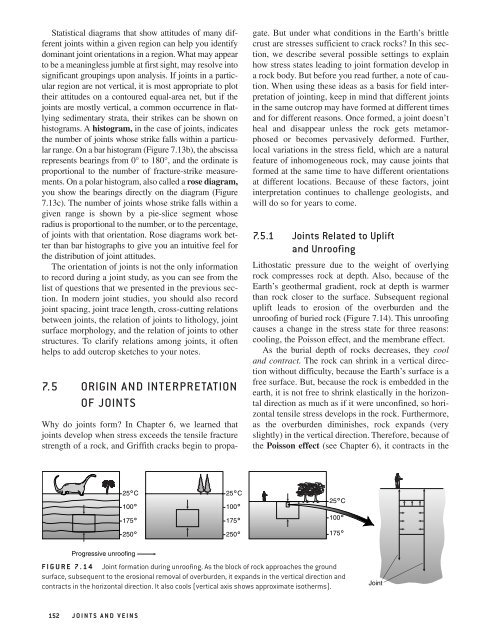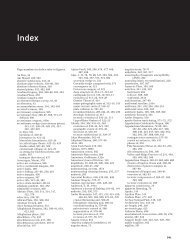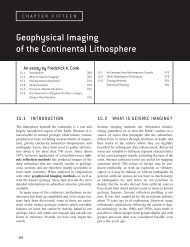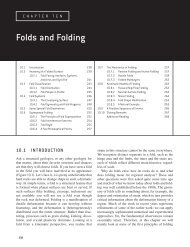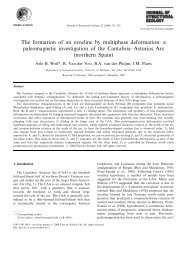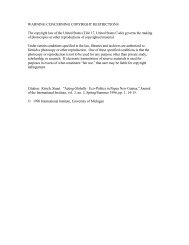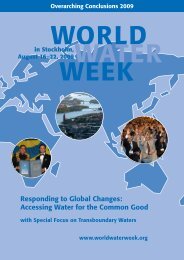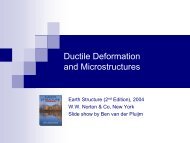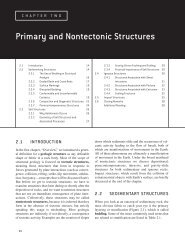Joints and Veins - Global Change
Joints and Veins - Global Change
Joints and Veins - Global Change
- No tags were found...
You also want an ePaper? Increase the reach of your titles
YUMPU automatically turns print PDFs into web optimized ePapers that Google loves.
2917-CH07.pdf 11/20/03 5:11 PM Page 152Statistical diagrams that show attitudes of many differentjoints within a given region can help you identifydominant joint orientations in a region. What may appearto be a meaningless jumble at first sight, may resolve intosignificant groupings upon analysis. If joints in a particularregion are not vertical, it is most appropriate to plottheir attitudes on a contoured equal-area net, but if thejoints are mostly vertical, a common occurrence in flatlyingsedimentary strata, their strikes can be shown onhistograms. A histogram, in the case of joints, indicatesthe number of joints whose strike falls within a particularrange. On a bar histogram (Figure 7.13b), the abscissarepresents bearings from 0° to 180°, <strong>and</strong> the ordinate isproportional to the number of fracture-strike measurements.On a polar histogram, also called a rose diagram,you show the bearings directly on the diagram (Figure7.13c). The number of joints whose strike falls within agiven range is shown by a pie-slice segment whoseradius is proportional to the number, or to the percentage,of joints with that orientation. Rose diagrams work betterthan bar histographs to give you an intuitive feel forthe distribution of joint attitudes.The orientation of joints is not the only informationto record during a joint study, as you can see from thelist of questions that we presented in the previous section.In modern joint studies, you should also recordjoint spacing, joint trace length, cross-cutting relationsbetween joints, the relation of joints to lithology, jointsurface morphology, <strong>and</strong> the relation of joints to otherstructures. To clarify relations among joints, it oftenhelps to add outcrop sketches to your notes.7.5 ORIGIN AND INTERPRETATIONOF JOINTSWhy do joints form? In Chapter 6, we learned thatjoints develop when stress exceeds the tensile fracturestrength of a rock, <strong>and</strong> Griffith cracks begin to propagate.But under what conditions in the Earth’s brittlecrust are stresses sufficient to crack rocks? In this section,we describe several possible settings to explainhow stress states leading to joint formation develop ina rock body. But before you read further, a note of caution.When using these ideas as a basis for field interpretationof jointing, keep in mind that different jointsin the same outcrop may have formed at different times<strong>and</strong> for different reasons. Once formed, a joint doesn’theal <strong>and</strong> disappear unless the rock gets metamorphosedor becomes pervasively deformed. Further,local variations in the stress field, which are a naturalfeature of inhomogeneous rock, may cause joints thatformed at the same time to have different orientationsat different locations. Because of these factors, jointinterpretation continues to challenge geologists, <strong>and</strong>will do so for years to come.7.5.1 <strong>Joints</strong> Related to Uplift<strong>and</strong> UnroofingLithostatic pressure due to the weight of overlyingrock compresses rock at depth. Also, because of theEarth’s geothermal gradient, rock at depth is warmerthan rock closer to the surface. Subsequent regionaluplift leads to erosion of the overburden <strong>and</strong> theunroofing of buried rock (Figure 7.14). This unroofingcauses a change in the stress state for three reasons:cooling, the Poisson effect, <strong>and</strong> the membrane effect.As the burial depth of rocks decreases, they cool<strong>and</strong> contract. The rock can shrink in a vertical directionwithout difficulty, because the Earth’s surface is afree surface. But, because the rock is embedded in theearth, it is not free to shrink elastically in the horizontaldirection as much as if it were unconfined, so horizontaltensile stress develops in the rock. Furthermore,as the overburden diminishes, rock exp<strong>and</strong>s (veryslightly) in the vertical direction. Therefore, because ofthe Poisson effect (see Chapter 6), it contracts in the25˚C100˚175˚250˚25˚C100˚175˚250˚25˚C100˚175˚Progressive unroofingFIGURE 7.14 Joint formation during unroofing. As the block of rock approaches the groundsurface, subsequent to the erosional removal of overburden, it exp<strong>and</strong>s in the vertical direction <strong>and</strong>contracts in the horizontal direction. It also cools (vertical axis shows approximate isotherms).Joint152 JOINTS AND VEINS


